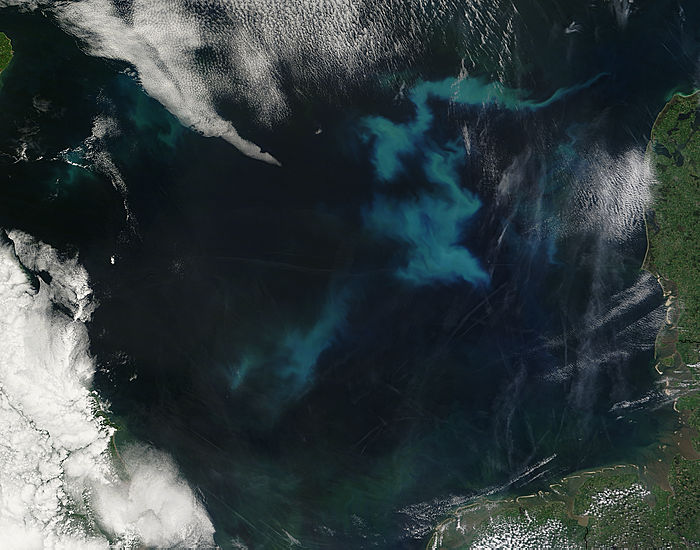North Sea Plankton Bloom Seen from Space (Photo)

Ghostly and blue-green, a phytoplankton bloom meanders across the North Sea in new satellite imagery.
The satellite image was taken by the Moderate Resolution Imaging Spectroradiometer (MODIS) on NASA's Terra satellite. Terra is part of a team; along with another NASA satellite, Aqua, it images the entire surface of the Earth every day or two.
The picture of the phytoplankton bloom was taken on May 30. Phytoplankton are microscopic plantlike organisms that drift in the oceans. Blooms occur when plankton encounter a vein of nutrients and go on a feeding (and multiplication) frenzy.
As the basis for the ocean food chain, phytoplankton use photosynthesis to convert sunlight into chemical energy. To do so, they use green chlorophyll, just like plants. It's this chlorophyll that paints the sea aquamarine during a phytoplankton bloom.
Phytoplankton blooms are generally harmless, but a few produce toxins. The dinoflagellate Alexandrium, for example, blooms red rather than green. This plankton is responsible for paralytic shellfish poisoning, which can be deadly in humans who ingest shellfish that have fed on Alexandrium. Not all red blooms (known as "red tides") are Alexandrium (in fact, it blooms rarely, according to the California Department of Public Health), and a bloom is not necessary for shellfish to accumulate the toxins. As a result, states like California have programs to monitor the water for these dangerous toxins.
Editor's Note: If you have an amazing ocean or general science photo you'd like to share for a possible story or image gallery, please contact managing editor Jeanna Bryner at LSphotos@livescience.com.
Follow Stephanie Pappas on Twitter and Google+. Follow us @livescience, Facebook & Google+. Original article on Live Science.
Get the world’s most fascinating discoveries delivered straight to your inbox.

Stephanie Pappas is a contributing writer for Live Science, covering topics ranging from geoscience to archaeology to the human brain and behavior. She was previously a senior writer for Live Science but is now a freelancer based in Denver, Colorado, and regularly contributes to Scientific American and The Monitor, the monthly magazine of the American Psychological Association. Stephanie received a bachelor's degree in psychology from the University of South Carolina and a graduate certificate in science communication from the University of California, Santa Cruz.


